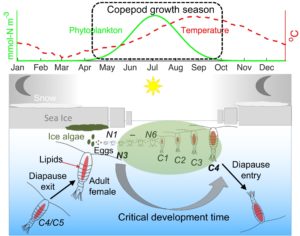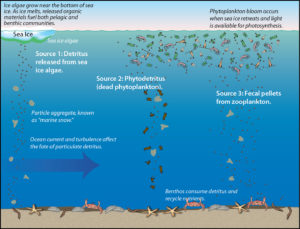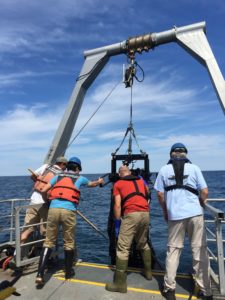Projects

Annual life cycle of the copepod C. glacialis in the Arctic/subarctic environment (Feng et al. 2017).
Project #1: Changes in Arctic Sea ice and their Impact on Timing of Life History and Production of Zooplankton
Arctic organisms are adapted to the strong seasonality of environmental forcing. A small timing mismatch between species' life histories and their physical and biological environment can have significant consequences for them and for the entire arctic ecosystem. Climate warming is likely to cause earlier snowmelt on sea ice and speed its retreat in the Arctic, thus causing variability in the timing (phenology) of marine primary production. Such changes will significantly impact the pelagic consumers that rely on that primary production. The focus of this study is to understand the coupling between the physical environment, the timing and magnitude of primary production, and the secondary production of pelagic consumers by focusing on a single dominant species, Calanus glacialis. The research combines a copepod individual-based model and a concentration-based biology-ice-ocean model into a spatially-explicit biological-physical coupled model (see picture), integrating remotely sensed and in-situ observational data and laboratory-derived copepod vital rates to project plankton production under future climate change scenarios.

Conceptual diagram illustrating sympagic-pelagic-benthic coupling in the shallow continental shelf ecosystem of northern Bering/Chukchi Sea.
Project #2: Formation and Persistence of Benthic Biological Hotspots in the Pacific Arctic
Persistently high macrofaunal benthic biomass has been observed at four major benthic hotspots in the Northern Bering and Chukchi Seas. These highly productive benthic communities are ecologically important and provide abundant prey for benthic-feeding marine mammals and seabirds. This study investigates the physical and biological processes that contribute to the formation of these benthic hotspots, and determines how changes in the Arctic system (including ice, ocean, and atmospheric forcing) will affect their formation and persistence. A better understanding of the mechanisms for the formation and persistence of these benthic hotspots is important and requires the atmosphere-ice-ocean system approach taken in this study, since these formation mechanisms involve multiple components of the Arctic system, including both biological and physical components of sea ice and ocean processes and atmospheric forcing.

Zooplankton sampling using a Multiple Opening and Closing Net with an Environmental Sensing System (MOCNESS) in the Gulf of Maine.
Project #3: Mechanisms supporting persistence of a key plankton species during climate change on the Northwest Atlantic continental shelf
In the Gulf of Maine region of the Northwest Atlantic Ocean, rapid warming of the ocean surface in recent years has raised concern in the research and resource management communities, fishing industry and the general public about effects on the coastal marine ecosystem. This interdisciplinary, collaborative project improves understanding of the physical and biological processes controlling the abundance of a planktonic animal that is particularly important in the food web of the northeast coastal ocean.